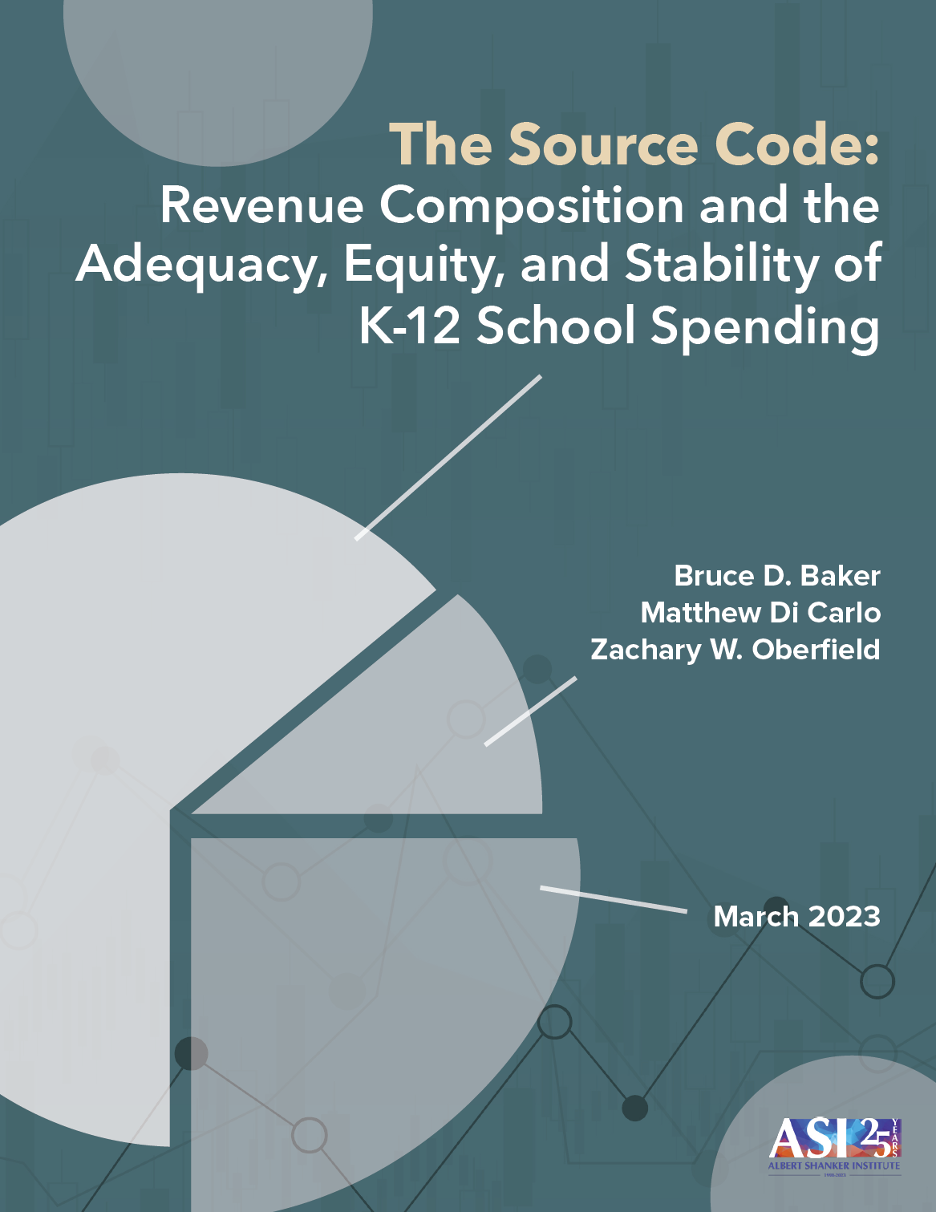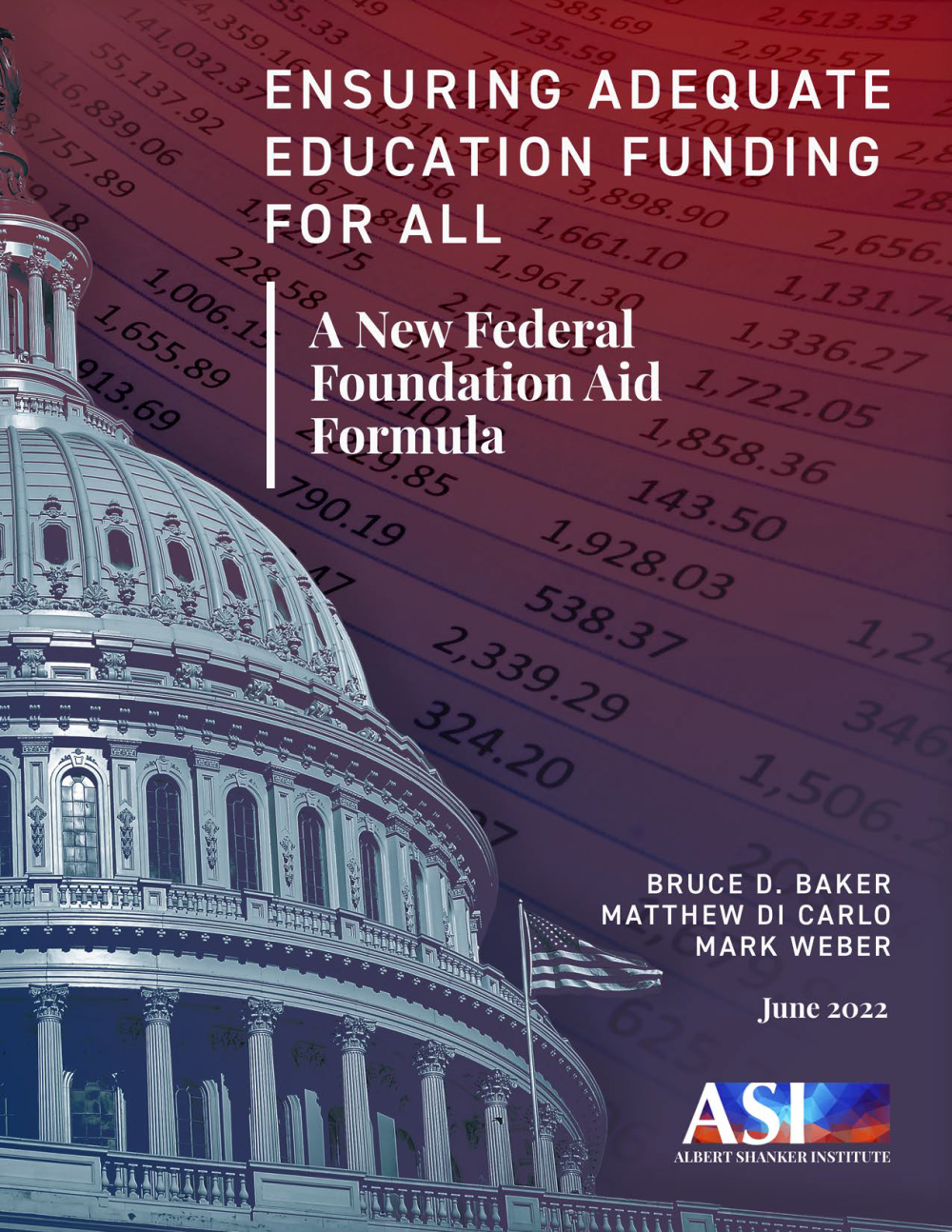Rethinking the Revenue Side of the K-12 Funding Equation
Most discussions of school funding focus on “how much.” There is a good reason for this: the end goal of any finance system is for all school districts to have enough to meet their students’ needs. Yet achieving this goal is as much about how money is allocated as it is about how much is raised (or spent) overall.
On average, about 45 percent of all K-12 revenue comes from state sources (e.g., sales and income tax), about 45 percent comes from local sources (mostly property tax), and the remaining 10 or so percent is federal aid. Yet these three revenue “streams” are typically handed out to districts in very different ways, and states vary widely in terms of their state/local “splits.” As a result, two states serving similar student populations might spend the same amount per pupil but exhibit vastly different adequacy and equity outcomes depending on the source of those funds and how they are allocated.
In a couple of recent Shanker Institute reports (here and here), we’ve been looking into this “revenue side” of the school finance equation, with a focus on finding better ways to collect and distribute all three sources of K-12 revenue (federal, state, and local), without necessarily increasing the overall amount of funding.
One useful starting point in evaluating each revenue “stream” is to do so using three key characteristics:
- Whether it’s distributed based on need (e.g., higher-poverty districts get more);
- Whether it’s distributed based on economic capacity/effort (e.g., it compensates for the fact that some states and districts can raise a lot of revenue and others cannot);
- Whether it’s relatively stable over time.
State aid, for example, is usually pooled and distributed based on need and capacity throughout the state. Districts are supposed to receive enough of this state aid to meet their students’ needs minus a reasonable “fair share” contribution in local revenue, with that fair share being larger in wealthier districts (though states vary widely in how well they do this).
Local revenue, in contrast, typically “stays home” where it is raised, which means it’s not allocated using need or capacity. However, local funds (mostly property taxes) are more stable over time than the sales and especially income tax dollars that feed state coffers. This stability is very important. It provides a buffer against budget shortfalls during economic downturns, and it also helps to attenuate the budgeting and hiring problems that often stem from uncertain funding even under normal economic conditions. Both of these issues affect higher-poverty districts more acutely than they do lower-poverty districts.
Finally, federal revenue is stable, and it is largely distributed based on need (e.g., Title I based on poverty). However, capacity/effort plays little role in federal K-12 aid allocation. Some states devote relatively large shares of their economies to their schools and other devote relatively small shares, but this generally does not directly affect their federal school funding.
In short, states vary quite a bit in where they get their school funds (the state/local “split”), how they distribute those funds, and the stability of their revenue regardless of source (some states’ economies are less volatile than others’), but the characterizations in the table below are how things have come to work in the vast majority of states. All three K-12 revenue sources have strengths and weaknesses but—and this is a key point—these strengths and weaknesses are not due to any inherent properties of these revenue streams. There is, for instance, no reason why residential property tax revenue can’t be pooled by the state and distributed the way other state funds are distributed, just as most sales taxes could theoretically be collected and distributed locally rather than by states (and, of course, in most states localities do collect some sales tax revenue).

These conventions are the result of decades of political wrangling and compromises and complex legislation. This is how school funding systems have developed over time, and we should be mindful of this. Massive proposals such as “eliminate the property tax and fund schools entirely with state revenue” or “pool all property tax revenue into the state fund and redistribute it” sound great, but would require a fundamental overhaul of pretty much every state’s entire K-12 funding system. They would also, as we’ll see, carry serious risks of their own even if they were put in place (e.g., Addonizio et al. 1995).
There are, however, somewhat less drastic solutions that might accomplish the same goals. Over the past year, we’ve published two reports offering some ideas on how states and the federal government might rethink how these revenue streams are collected and distributed and turn some of the red cells in the table above into green cells—i.e., they would improve the degree to which funding is both reliable and gets where it is needed most.
Our more recent report, published last month (with Bruce Baker and Zach Oberfield), focuses on state and local revenue. We run some descriptive models with panel data showing that, independent of how much they spend overall, states that rely more on state revenue (versus local revenue) tend to have more adequate and equitable funding, but also more volatile funding. This is essentially a trade-off, which you can see represented in the table above—state revenue is distributed based on need and capacity/effort (increases adequacy/equity), but local revenue is more stable over time.

We offer two recommendations based on these results. First, and most generally, we caution against proposals to completely replace local revenue with state revenue, as doing so may address one problem (inequity) but exacerbate another (volatility) that is also of particular concern to higher-poverty districts. But our second and more actionable recommendations consist of policies that exploit the strengths and weaknesses of state and local revenue.
Most notably, we suggest that states—rather than localities—might tax commercial and industrial (not residential) property, and pool and distribute those funds the way most state aid is distributed. This approach, which was first proposed decades ago (Ladd 1976; Ladd and Harris 1995), is the best of both worlds, so to speak: it could, in many states, move a significant chunk of that stable property tax revenue into the state aid pool, where it could be distributed based on need/capacity. Moreover, it is well within the realm of political possibility: a policy of this type was only narrowly defeated in California in 2020.
(Note that there is an additional important consideration when evaluating different types of taxes: whether or not they are progressive for taxpayers. We discuss this issue in the report.)
Our second report, published earlier this year (with Bruce Baker and Mark Weber), focuses on federal aid. We propose and simulate a “federal foundation aid” program by which federal K-12 funds are distributed based not only on need (as is currently the case), but also on states’ willingness and ability to put forth a reasonable minimum “effort” level (i.e., to spend a reasonable proportion of their economies on their public schools). In other words, we are proposing that federal aid be distributed in part based on capacity/effort, which is essentially how state and local K-12 revenue works.

In our “proof of concept” simulation of this program (which we carry out district-by-district using a detailed process), we set this reasonable minimum effort level at roughly the national average, and so many states already meet it. These states, in our simulation, receive federal funds sufficient to bring all their districts up to spending levels adequate to achieve national average testing outcomes. States that, in contrast, do not meet this minimum requirement would have to gradually increase their effort levels in order to be eligible, and they too would receive federal funding to achieve universal adequacy.
This simulated proposal is a fundamental change to federal K-12 funding and would require major legislation. It is also an extremely ambitious proposal. According to our simulation, were it to be fully implemented with all states complying, it would bring all districts up to adequate spending levels, which we estimate would require federal K-12 aid roughly to double (the report is accompanied by an online data visualization tool with which users can simulate this proposal using different parameters).
The core underlying idea, however, is that federal school funding should be based in part on states’ ability and willingness to put forth reasonable minimum effort levels in order to ensure that the funds are going where they are most needed—at states and districts where the ability to raise revenue is insufficient to meet students’ needs. This kind of change does not necessarily require an increase in federal funding, as it is fundamentally focused on “how” rather than “how much.”
Our overall approach in these two reports, to reiterate, is about looking at the revenue side of the equation for ways to improve how K-12 funds are collected and distributed largely independently of how much money there is to go around. To be clear, there is a limit on how well these policies can work in states where overall funding is low, but they embody the kinds of ideas that can help supplement the typical “how much” debates with proposals focused on getting stable funding streams directed where they are most needed.
